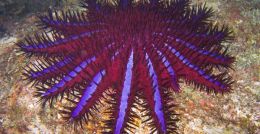Starfish-killing robot to help save Great Barrier Reef
A team of scientists from Queensland University of Technology (QUT) have developed a robot to help decrease the population of crown-of-thorn starfish (COTS) which are damaging the Great Barrier Reef. The number of starfish has increased and it is estimated that they are responsible for around 40 per cent of the reef’s total decline in coral cover.

Dr Matthew Dunbabin from QUT’S Institute for Future Environments explained that roboticists have spent the last six months developing and training the robot known as COTSbot to recognise COTS among coral in order to reduce the damage they cause. The machine is specially designed to cope with working in the difficult to navigate area within one metre of the ocean floor. It is equipped with stereoscopic cameras to give it depth perception, five thrusters to maintain stability, GPS, pitch-and-roll sensors and a unique pneumatic injection arm to deliver a fatal dose of bile salts to any COTS detected.
The vision system for detecting COTS from underwater images was actually developed by Dr Dunbabin ten years ago. However, at that point it was still necessary for divers to inject each starfish up to 20 times to eradicate them so he shelved the idea of the robot. The project was revived after researchers at James Cook University developed a one-shot injection in 2014, making the idea of using a robot more realistic.
Crucially, the COTSbot is designed to learn from its experiences in the field to improve future performance. Dr Feras Dayoub, from QUT’S Science and Engineering Faculty who designed the COTS-detecting software, explained that “its computer system is backed by some serious computational power so the COTSbot can think for itself in the water. If the robot is unsure that something is actually a COTS, it takes a photo of the object to be later verified by a human, and that human feedback is incorporated into the robot’s memory bank. That in itself is quite an accomplishment given the complexity of underwater environments, which are subject to varying visibility as well as depth-dependent colour changes.”
Human divers are currently working hard to eradicate the COTS in specific areas but the COTbot will hopefully speed up the process as they can work day and night, in any weather conditions. Dr Dunbabin said “We see the COTSbot as a first responder for ongoing eradication programs – deployed to eliminate the bulk of COTS in any area, with divers following a few days later to hit the remaining COTS.”
The team hope that a fleet of COTSbots could soon be deployed. It has completed its first sea trials in Queensland’s Moreton Bay to test its mechanical parts and navigation system. The next stage this September is to take it to the Great Barrier Reef to test it against real starfish. Initially the robot will simply take a photograph of any suspected COTS and a human will verify each COTS identification before the robot is allowed to inject it. The team hope that by December the COTSbot will be working unassisted and they are seeking funding to scale up its manufacture and deployment.
